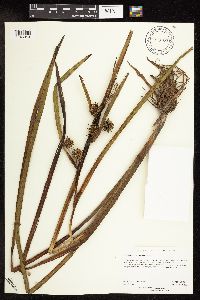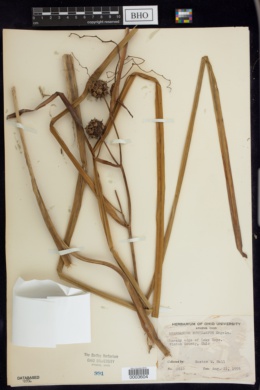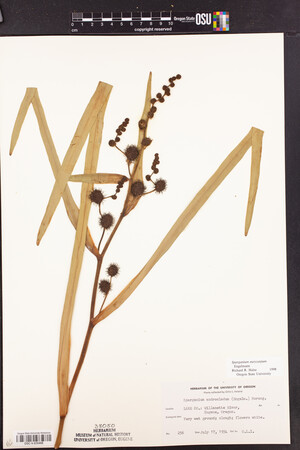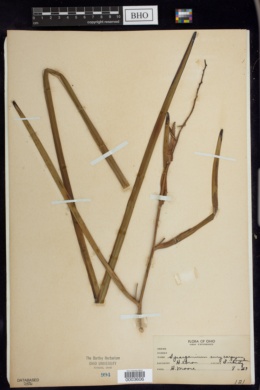Sparganium eurycarpum
|
|
|
|
Family: Typhaceae
Broad-Fruit Burr-Reed, more...broadfruit bur-reed, broadfruit burreed, giant burreed
[Sparganium californicum Greene, moreSparganium eurycarpum subsp. eurycarpum , Sparganium eurycarpum var. greenei (Morong) Graebn., Sparganium greenei Morong] |
Plants robust, to 2.5 m; leaves and inflorescences emergent. Leaves erect, keeled but sometimes distally flattened, to 2.5 m 6--20 mm. Inflorescences: rachis usually branched, erect; bracts ascending, not basally inflated; pistillate heads (1--)2--6(--8), axillary, not contiguous, peduncled on main rachis, sessile on branches, 1.5--5 cm diam. in fruit; staminate heads 10--40+, on main rachis and branches, lower proximal not contiguous, distal often crowded. Flowers: tepals often with dark subapical spot, entire to subentire; stigmas usually 2, often some flowers in head with 1, linear. Fruits straw-colored, darkening with age, somewhat lustrous, sessile, obpyramidal, body 3--7-faceted proximal to prominent shoulder, depressed-truncate to somewhat rounded or tapering distally, not constricted at equator, body 5--10 mm and often nearly as wide, gradually or abruptly beaked; beak straight, 2--4 mm, tepals attached at base, reaching to shoulder, about equaling body. Seeds 1--2(3), bistigmatic flowers often with 2, unistigmatic flowers with 1. 2n = 30. Flowering spring--fall summer (Apr--Oct southward, Jun--Jul northward). Lowland marshes, shores, and ditches, mostly in neutral-to-alkaline, hard, and even brackish waters on mud, sand, or gravel, sometimes among boulders on wave-washed shores, tolerant of some desiccation; 0--1600 m; St. Pierre and Miquelon; Alta., B.C., Man., N.B., Nfld. and Labr. (Nfld.), N.W.T., N.S., Ont., P.E.I., Que., Sask.; Ariz., Calif., Colo., Conn., Del., Idaho, Ill., Ind., Iowa, Kans., Ky., Maine, Md., Mass., Mich., Minn., Mo., Mont., Nebr., Nev., N.H., N.J., N.Mex., N.Y., N.Dak., N.Y., Ohio, Okla., Oreg., Pa., R.I., S.Dak., Utah, Vt., Va., Wash., W.Va., Wis., Wyo.; Mexico (Baja California); e Asia. Sparganium eurycarpum grows mostly near the coast (but not in salt marshes) in New England (G. E. Crow and C. B. Hellquist 1981), mostly in the interior in British Columbia (T. C. Brayshaw 1985), and in coastal and interior sites from Washington to Baja California. It is locally common to abundant in fresh to somewhat brackish waters across the continent but is less frequent toward its northern and southern limits. Both stigmas of bistigmatic flowers often persist on the fruits, but sometimes one or both break away. The fruits of bistigmatic and 2-ovuled flowers are often larger than those of unistigmatic flowers. From southern British Columbia to Baja California, especially near the coast but also at scattered sites inland, some plants having fewer bistigmatic flowers and smaller, rounded or tapering fruits have been called Sparganium eurycarpum var. greenei (Morong) Graebner or S. greenei Morong by some authors (e.g., H. L. Mason 1957; T. C. Brayshaw 1985) but not by others (e.g., C. L. Hitchcock 1969et al. 1955--1969, vol. 1; J. L. Reveal 1977A. Cronquist et al. 1972+, vol. 6). Such plants were placed in S. erectum Linnaeus, the strongly polymorphic and ecotypically variable Eurasian vicariant species, as S. erectum subsp. stoloniferum (Hamilton ex Graebner) C. D. K. Cook & M. S. Nicholls (C. D. K. Cook and M. S. Nicholls 1987). Sparganium eurycarpum is only weakly distinguished from S. erectum, largely on the basis of relative preponderance of bi- and unistigmatic flowers (± 50% in the two species, respectively), and by concomitant differences in fruit size and shape. In North America, however, some unistigmatic flowers occur among bistigmatic flowers on pistillate heads of many plants throughout the range of S. eurycarpum. Such unistigmatic flowers are common on some west-coast plants and on plants of alkaline marshes of the Great Basin and Great Plains, although there is considerable variation in all three areas. Because of these widespread variations, and in the absence of definitive, rangewide, comparative studies, our plants are here treated as S. eurycarpum. Comparative studies of Eurasian and North American plants, however, perhaps would show that all are best treated as S. erectum, the name with priority, but no such studies have been made.
Plant: perennial herb; Stems 5-25 dm tall, erect, stout, branching Leaves: 3-10 dm long, 7-17 mm wide, equalling to shorter than the inflorescence, flat, somewhat keeled below INFLORESCENCE: branched, 1.5-5 dm long, the upper branches with 5-12 staminate heads, these sessile or peduncled, 2-3 cm in diam. when mature; pistillate heads 2-6 on the main stem or on branches, sessile or usually peduncled, 2-2.5 cm diam. in fruit Flowers: STAMINATE FLOWERS: perianth scales 3-7 mm long, clawed, expanded and spatulate with irregularly lobed hyaline margined apex; anthers 1-1.5 mm long, elliptic-clavate. PISTILLATE FLOWERS: perianth scales almost as long as the fruits, long-clawed, expanded and spatulate, with irregularly lobed hyaline-margined apex; style branches 2, rarely simple, filiform, 1.8-2 mm long Fruit: FRUITS mostly 2-seeded, 6-10 mm long, 4-8 mm wide at apex, sessile, hard and thick at maturity, cuneate-obpyramidal, irregularly and obtusely 3-5-angled, the tip truncate to depressed or very shallowly rounded, the stout beak 2-3 mm long Misc: Wet meadows and along streams; 2100-2150 m (7000-7100 ft); May-Sep REFERENCES: Ricketson, Jon. 2001. Sparganiaceae. J. Ariz. - Nev. Acad. Sci. Volume 33(1). Perennial aquatic herb to 2.5 m tall Leaves: emersed, to 2.5 m long, 6 - 20 mm wide, erect, longitudinally folded, sometimes flattened near the tip. Inflorescence: emersed, bracts ascending but not inflated near base, main axis usually branched and erect. Ten to 40 or more male flower heads form on the main axis and branches, with the uppermost often tightly clustered. Two to six axillary female flower heads are stalked on the main axis but stalkless on the branches, not tightly clustered. Flowers: tiny, tepals often having a dark spot near the more or less toothless tip, usually with two linear stigmas (sometimes one). Fruit: an achene-like drupe borne on a head 1.5 - 5 cm across, slightly shiny and straw-colored, 5 - 10 mm long and almost as wide, inverse pyramidal, depressed-squared to somewhat rounded or tapering to a straight beak 2 - 4 mm long, not constricted near the middle, with persistent tepals nearly as long as the fruit. Fruit from flowers with two stigmas usually produce two seeds, while those from flowers with one stigma produce a single seed. Similar species: Sparganium americanum, Sparganium androcladum, Sparganium emersum, Sparganium natans, and Sparganium angustifolium each have only one stigma per female flower. Flowering: late May to late August Habitat and ecology: Frequent in marshes, muddy ditches, and shallow water. Occurence in the Chicago region: native Etymology: Sparganium comes from the Greek word sparganion, a derivation of the word sparganon, meaning swaddling-band. This refers to the ribbon-like leaves of these plants. Eurycarpum means broad-fruited. Author: The Morton Arboretum Stout, erect, 5-12 dm; lvs to 8 dm, 6-12 mm wide, scarcely dilated at base, the bracts similar but shorter; infl branched, the branches from the lower axils with retuse, or abruptly rounded to the stout 3 mm beak; stigmas 2, linear; ovules, seeds, and locules 2; 2n=30. In mud or shallow water; Que. and N.S. to B.C., s. to Va., Ind., Okla. and Calif. Gleason, Henry A. & Cronquist, Arthur J. 1991. Manual of vascular plants of northeastern United States and adjacent Canada. lxxv + 910 pp. ©The New York Botanical Garden. All rights reserved. Used by permission. From Flora of Indiana (1940) by Charles C. Deam Infrequent to frequent in the lake area and rare or possibly absent from the southern part of the state. There are only three reports for it south of Hamilton County, and it is barely possible that these should be referred to the next species [Sparganium androcladum]. It is found in wet places, mostly in ditches. It also occurs on the low borders of lakes, streams, and sloughs and in ponds and springy places. …… Indiana Coefficient of Conservatism: C = 5 Wetland Indicator Status: OBL |
|
|
|



























































































